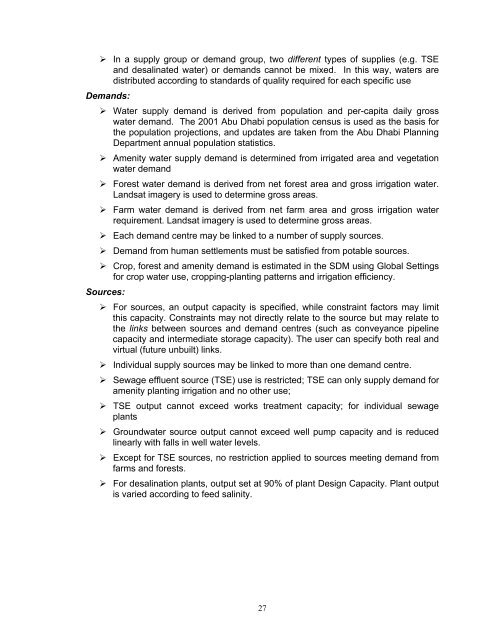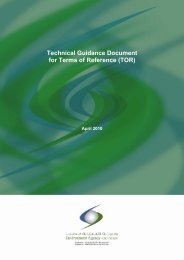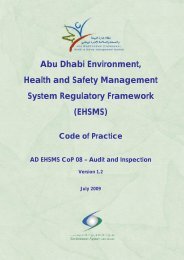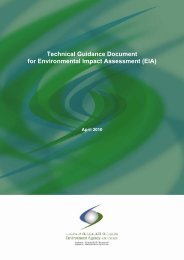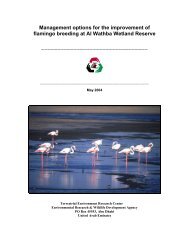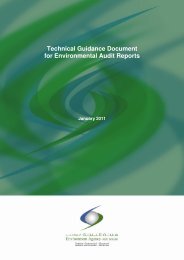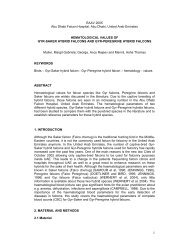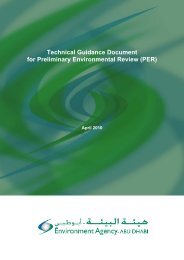Assessment of the Water Situation in the Western Region
Assessment of the Water Situation in the Western Region
Assessment of the Water Situation in the Western Region
Create successful ePaper yourself
Turn your PDF publications into a flip-book with our unique Google optimized e-Paper software.
‣ In a supply group or demand group, two different types <strong>of</strong> supplies (e.g. TSEand desal<strong>in</strong>ated water) or demands cannot be mixed. In this way, waters aredistributed accord<strong>in</strong>g to standards <strong>of</strong> quality required for each specific useDemands:‣ <strong>Water</strong> supply demand is derived from population and per-capita daily grosswater demand. The 2001 Abu Dhabi population census is used as <strong>the</strong> basis for<strong>the</strong> population projections, and updates are taken from <strong>the</strong> Abu Dhabi Plann<strong>in</strong>gDepartment annual population statistics.‣ Amenity water supply demand is determ<strong>in</strong>ed from irrigated area and vegetationwater demand‣ Forest water demand is derived from net forest area and gross irrigation water.Landsat imagery is used to determ<strong>in</strong>e gross areas.‣ Farm water demand is derived from net farm area and gross irrigation waterrequirement. Landsat imagery is used to determ<strong>in</strong>e gross areas.‣ Each demand centre may be l<strong>in</strong>ked to a number <strong>of</strong> supply sources.‣ Demand from human settlements must be satisfied from potable sources.‣ Crop, forest and amenity demand is estimated <strong>in</strong> <strong>the</strong> SDM us<strong>in</strong>g Global Sett<strong>in</strong>gsfor crop water use, cropp<strong>in</strong>g-plant<strong>in</strong>g patterns and irrigation efficiency.Sources:‣ For sources, an output capacity is specified, while constra<strong>in</strong>t factors may limitthis capacity. Constra<strong>in</strong>ts may not directly relate to <strong>the</strong> source but may relate to<strong>the</strong> l<strong>in</strong>ks between sources and demand centres (such as conveyance pipel<strong>in</strong>ecapacity and <strong>in</strong>termediate storage capacity). The user can specify both real andvirtual (future unbuilt) l<strong>in</strong>ks.‣ Individual supply sources may be l<strong>in</strong>ked to more than one demand centre.‣ Sewage effluent source (TSE) use is restricted; TSE can only supply demand foramenity plant<strong>in</strong>g irrigation and no o<strong>the</strong>r use;‣ TSE output cannot exceed works treatment capacity; for <strong>in</strong>dividual sewageplants‣ Groundwater source output cannot exceed well pump capacity and is reducedl<strong>in</strong>early with falls <strong>in</strong> well water levels.‣ Except for TSE sources, no restriction applied to sources meet<strong>in</strong>g demand fromfarms and forests.‣ For desal<strong>in</strong>ation plants, output set at 90% <strong>of</strong> plant Design Capacity. Plant outputis varied accord<strong>in</strong>g to feed sal<strong>in</strong>ity.27


